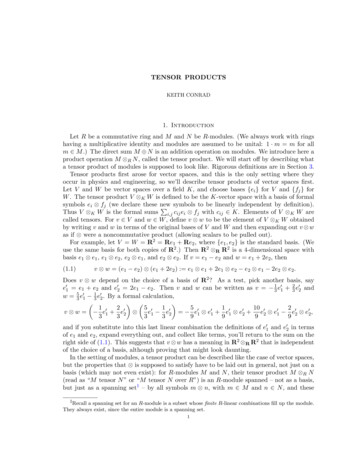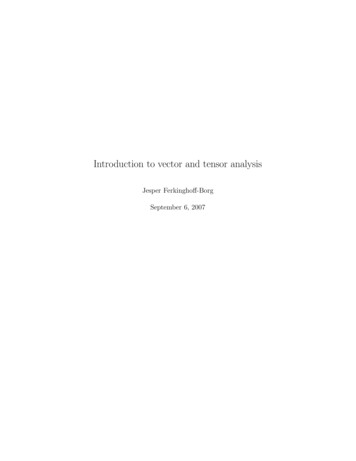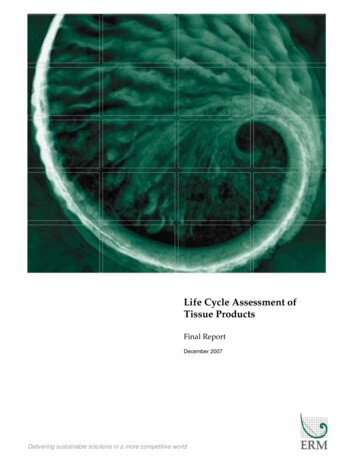
Transcription
TENSOR PRODUCTSKEITH CONRAD1. IntroductionLet R be a commutative ring and M and N be R-modules. (We always work with ringshaving a multiplicative identity and modules are assumed to be unital: 1 · m m for allm M .) The direct sum M N is an addition operation on modules. We introduce here aproduct operation M R N , called the tensor product. We will start off by describing whata tensor product of modules is supposed to look like. Rigorous definitions are in Section 3.Tensor products first arose for vector spaces, and this is the only setting where theyoccur in physics and engineering, so we’ll describe tensor products of vector spaces first.Let V and W be vector spaces over a field K, and choose bases {ei } for V and {fj } forW . The tensor product V K W is defined to be the K-vector space with a basis of formalsymbols ei fj (we declare these newP symbols to be linearly independent by definition).Thus V K W is the formal sums i,j cij ei fj with cij K. Elements of V K W arecalled tensors. For v V and w W , define v w to be the element of V K W obtainedby writing v and w in terms of the original bases of V and W and then expanding out v was if were a noncommutative product (allowing scalars to be pulled out).For example, let V W R2 Re1 Re2 , where {e1 , e2 } is the standard basis. (Weuse the same basis for both copies of R2 .) Then R2 R R2 is a 4-dimensional space withbasis e1 e1 , e1 e2 , e2 e1 , and e2 e2 . If v e1 e2 and w e1 2e2 , then(1.1)v w (e1 e2 ) (e1 2e2 ) : e1 e1 2e1 e2 e2 e1 2e2 e2 .Does v w depend on the choice of a basis of R2 ? As a test, pick another basis, saye01 e1 e2 and e02 2e1 e2 . Then v and w can be written as v 13 e01 23 e02 andw 53 e01 31 e02 . By a formal calculation, 2 01 011021 05 05v w e1 e2 e1 e2 e01 e01 e01 e02 e02 e01 e02 e02 ,33339999and if you substitute into this last linear combination the definitions of e01 and e02 in termsof e1 and e2 , expand everything out, and collect like terms, you’ll return to the sum on theright side of (1.1). This suggests that v w has a meaning in R2 R R2 that is independentof the choice of a basis, although proving that might look daunting.In the setting of modules, a tensor product can be described like the case of vector spaces,but the properties that is supposed to satisfy have to be laid out in general, not just on abasis (which may not even exist): for R-modules M and N , their tensor product M R N(read as “M tensor N ” or “M tensor N over R”) is an R-module spanned – not as a basis,but just as a spanning set1 – by all symbols m n, with m M and n N , and these1Recall a spanning set for an R-module is a subset whose finite R-linear combinations fill up the module.They always exist, since the entire module is a spanning set.1
2KEITH CONRADsymbols satisfy distributive laws:(1.2)(m m0 ) n m n m0 n, m (n n0 ) m n m n0 .Also multiplication by r R can be put into either side of : for m M and n N ,(1.3)r(m n) (rm) n m (rn).Therefore writing rm n is unambiguous: it is both r(m n) and (rm) n.The formulas (1.2) and (1.3) in M R N should be contrasted with those for the directsum M N , where(m m0 , n) (m, n) (m0 , 0),r(m, n) (rm, rn).In M N , an element (m, n) decomposes as (m, 0) (0, n), but m n in M R N doesnot break apart. While every element of M N is a pair (m, n), there are usually moreelements of M R N than the products m n. The general element of M R N , which iscalled a tensor, is an R-linear combination2r1 (m1 n1 ) r2 (m2 n2 ) · · · rk (mk nk ),where k 1, ri R, mi M , and ni N . Since ri (mi ni ) (ri mi ) ni , we can renameri mi as mi and write the above linear combination as a sum(1.4)m1 n1 m2 n2 · · · mk nk .In the direct sum M N , equality is easy to define: (m, n) (m0 , n0 ) if and only ifm m0 and n n0 . When are two sums of the form (1.4) equal in M R N ? This is noteasy to say in terms of the description of a tensor product that we have given, except inone case: M and N are free R-modules with bases {ei } and {fj }. In thisP case, M R N isfree with basis {ei fj }, so every element of M R N is a (finite) sum i,j cij ei fj withcij R and two such sums are equal only when coefficients of like terms are equal.To describe equality in M R N when M and N don’t have bases, we will use a universalmapping property of M R N . The tensor product is the first concept in algebra whoseproperties make consistent sense only by a universal mapping property, which is: M R Nis the universal object that turns bilinear maps on M N into linear maps. As JeremyKun [12] writes, M R N is the “gatekeeper” of all bilinear maps out of M N .After a discussion of bilinear (and multilinear) maps in Section 2, the definition andconstruction of the tensor product is presented in Section 3. Examples of tensor productsare in Section 4. In Section 5 we will show how the tensor product interacts with some otherconstructions on modules. Section 6 describes the important operation of base extension,which is a process of using tensor products to turn an R-module into an S-module where Sis another ring. Finally, in Section 7 we describe the notation used for tensors in physics.Here is a brief history of tensors and tensor products. Tensor comes from the Latintendere, which means “to stretch.” In 1822 Cauchy introduced the Cauchy stress tensorin continuum mechanics, and in 1861 Riemann created the Riemann curvature tensor ingeometry, but they did not use those names. In 1884, Gibbs [6, Chap. 3] introduced tensorproducts of vectors in R3 with the label “indeterminate product”3 and applied it to study2Compare with the polynomial ring R[X, Y ], whose elements are not only products f (X)g(Y ), but sumsPof such products i,j aij X i Y j . It turns out that R[X, Y ] R[X] R R[Y ] as R-modules (Example 4.12).3The label indeterminate was chosen because Gibbs considered this product to be, in his words, “themost general form of product of two vectors,” as it is subject to no laws except bilinearity, which must besatisfied by any operation on vectors that deserves to be called a product.
TENSOR PRODUCTS3strain on a body. He extended the indeterminate product to n dimensions in 1886 [7].Voigt used tensors to describe stress and strain on crystals in 1898 [23], and the term tensorfirst appeared with its modern physical meaning there.4 In geometry Ricci used tensors inthe late 1800s and his 1901 paper [20] with Levi-Civita (in English in [14]) was crucial inEinstein’s work on general relativity. Wide use of the term “tensor” in physics and mathis due to Einstein; Ricci and Levi-Civita called tensors by the bland name “systems”. Thenotation is due to Murray and von Neumann in 1936 [16, Chap. II] for tensor products(they wrote “direct products”) of Hilbert spaces.5 The tensor product of abelian groups Aand B, with that name but written as A B instead of A Z B, is due to Whitney [25] in1938. Tensor products of modules over a commutative ring are due to Bourbaki [2] in 1948.2. Bilinear MapsWe already described the elements of M R N as sums (1.4) subject to the rules (1.2)and (1.3). The intention is that M R N is the “freest” object satisfying (1.2) and (1.3).The essence of (1.2) and (1.3) is bilinearity. What does that mean?A function B : M N P , where M , N , and P are R-modules, is called bilinear if it islinear (that is, R-linear) in each argument when the other one fixed:B(m1 m2 , n) B(m1 , n) B(m2 , n),B(rm, n) rB(m, n),B(m, n1 n2 ) B(m, n1 ) B(m, n2 ),B(m, rn) rB(m, n).So B( , n) is a linear map M P for each n and B(m, ) is a linear map N P for eachm. In particular, B(0, n) 0 and B(m, 0) 0. Here are some examples of bilinear maps.(1) The dot product v · w on Rn is a bilinear function Rn Rn R. More generally,for A Mn (R) the function hv, wi v · Aw is a bilinear map Rn Rn R.(2) Matrix multiplication Mm,n (R) Mn,p (R) Mm,p (R) is bilinear. The dot productis the special case m p 1 (writing v · w as v w).(3) The cross product v w is a bilinear function R3 R3 R3 .(4) The determinant det : M2 (R) R is a bilinear function of matrix columns.(5) For an R-module M , scalar multiplication R M M is bilinear.(6) Multiplication R R R is bilinear.(7) Set the dual module of M to be M HomR (M, R). The dual pairing M M Rgiven by (ϕ, m) 7 ϕ(m) is bilinear.(8) For ϕ M and ψ N , the map M N R where (m, n) 7 ϕ(m)ψ(n) isbilinear.BLL B(9) If M N P is bilinear and P Q is linear, the composite M N Qis bilinear. (This is a very important example. Check it!)(10) From Section 1, the expression m n is supposed to be bilinear in m and n. Thatis, we want the function M N M R N given by (m, n) 7 m n to be bilinear.Here are a few examples of functions of two arguments that are not bilinear:(1) For an R-module M , addition M M M , where (m, m0 ) 7 m m0 , is usually notbilinear: it is usually not additive in m when m0 is fixed (that is, (m1 m2 ) m0 6 (m1 m0 ) (m2 m0 ) in general) or additive in m0 when m is fixed.4Writing i, j, and k for the standard basis of R3 , Gibbs called a sum ai i bj j ck k with positivea, b, and c a right tensor [6, p. 57], but I don’t know if this had an influence on Voigt’s terminology.5I thank Jim Casey for bringing [16] to my attention.
4KEITH CONRAD(2) For ϕ M and ψ N , the sum M N R given by (m, n) 7 ϕ(m) ψ(n) isusually not bilinear.(3) Treat Mn (C) as a C-vector space. The function Mn (C) Mn (C) Mn (C) givenby (A, B) 7 AB is not bilinear. It is biadditive (i.e., additive in each componentwhen the other one is fixed) but look at how scalar multiplication behaves in thesecond component: for z C, AzB is z(AB) rather than z(AB).For two R-modules M and N , M N and M N are the same sets, but M N is anR-module and M N doesn’t have a module structure. For example, addition on R is alinear function R R R, but addition on R is not a bilinear function R R R, as wesaw above. Multiplication as a function R R R is bilinear, but as a function R R Rit is not linear (e.g., (r r0 )(s s0 ) 6 rs r0 s0 in general). Linear functions are generalizedadditions and bilinear functions are generalized multiplications. Don’t confuse a bilinearfunction on M N with a linear function on M N .For R-modules M1 , . . . , Mk , a function f : M1 · · · Mk M is called multilinearor k-multilinear if f (m1 , . . . , mk ) is linear (that is, R-linear) in each mi when the othercoordinates are fixed. So 2-multilinear means bilinear. Here are some multilinear functions:(1) The scalar triple product u · (v w) is trilinear R3 R3 R3 R.(2) The function f (u, v, w) (u · v)w is trilinear Rn Rn Rn Rn .(3) The function M M N N given by (ϕ, m, n) 7 ϕ(m)n is trilinear.(4) If B : M N P and B 0 : P Q T are bilinear then M N Q T by(m, n, q) 7 B 0 (B(m, n), q) is trilinear.(5) Multiplication R · · · R R with k factors is k-multilinear.(6) The determinant det : Mn (R) R, as a function of matrix columns, is n-multilinear.fL(7) If M1 · · · Mk M is k-multilinear and M N is linear then the compositeL fM1 · · · Mk N is k-multilinear.(8) For f : Rm Rn and x Rm , the kth derivative (Dk f )x : (Rm )k Rn is kmultilinear. (If you’re unfamiliar with 1st derivatives as linear maps, ignore this.)The R-linear maps M N form an R-module HomR (M, N ) under addition of functionsand R-scaling. The R-bilinear maps M N P form an R-module BilR (M, N ; P ) in thesame way. However, unlike linear maps, bilinear maps are missing some features:(1) There is no “kernel” of a bilinear map M N P since M N is not a module.(2) The image of a bilinear map M N P need not form a submodule.Example 2.1. Define B : Rn Rn Mn (R) by B(v, w) vw , where v and w arecolumn vectors, so vw is n n. For example, when n 2, a1b1a1a1 b1 a1 b2B, (b1 , b2 ) .a2 b1 a2 b2a2b2a2PPGenerally, if v ai ei and w bj ej in terms of the standard basis of Rn , then vw isthe n n matrix (ai bj ). This matrix is R-bilinear in v and w, so B is bilinear. For n 2the image of B isn’t closed under addition, so it isn’t a subspace of Mn (R). Why? Eachmatrix B(v, w) has rank 1 (or 0) since its columns are scalar multiples of v. The matrix 1 0 ··· 0 0 1 ··· 0 B(e1 , e1 ) B(e2 , e2 ) e1 e ee . . . . 2 21 . . . 0 0 ···0
TENSOR PRODUCTS5has a 2-dimensionalimage, so B(e1 , e1 ) B(e2 , e2 ) 6 B(v, w) for all v and w in Rn .Pn(Similarly, i 1 B(ei , ei ) is the n n identity matrix, which is not of the form B(v, w).)3. Construction of the Tensor ProductAny bilinear map M N P to an R-module P can be composed with a linear mapP Q to get a map M N Q that is bilinear.;PbilinearM Nlinear# composite is bilinear!QWe will construct the tensor product of M and N as a solution to a universal mappingproblem: find an R-module T and bilinear map b : M N T such that every bilinearmap on M N is the composite of the bilinear map b and a unique linear map out of T .;TbM N linear?# bilinearPThis is analogous to the universal mapping property of the abelianization G/[G, G] of agroup G: homomorphisms G A with abelian A are “the same” as homomorphismsG/[G, G] A because every homomorphism f : G A is the composite of the canonicalhomomorphism π : G G/[G, G] with a unique homomorphism fe: G/[G, G] A.G/[G, G]:πGfe fADefinition 3.1. The tensor product M R N is an R-module equipped with a bilinear map BM N M R N such that for each bilinear map M N P there is a uniqueLlinear map M R N P making the following diagram commute. M8 R NM NLB& P
6KEITH CONRADWhile the functions in the uni
is due to Einstein; Ricci and Levi-Civita called tensors by the bland name \systems". The notation is due to Murray and von Neumann in 1936 [16, Chap. II] for tensor products (they wrote \direct products") of Hilbert spaces.5 The tensor product of abelian groups A and B, with that name but written as A Binstead of A Z B, is due to Whitney [25] in 1938. Tensor products of modules over a .











